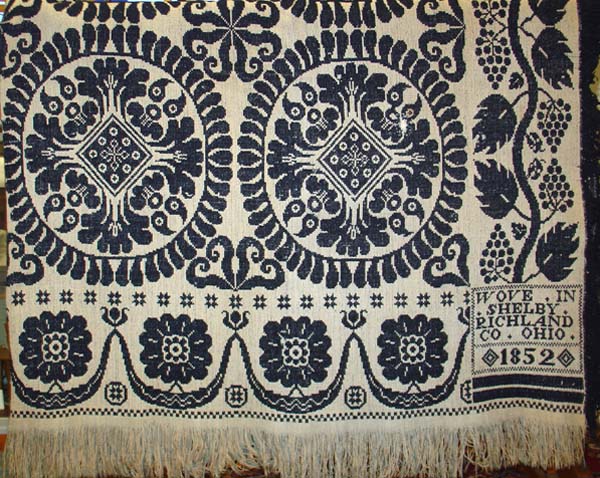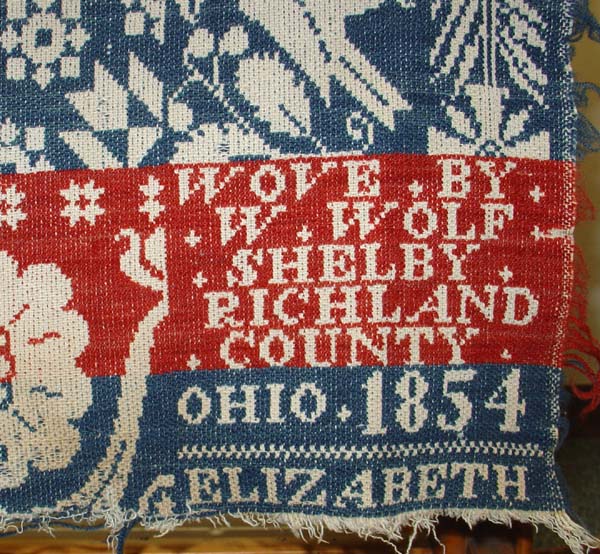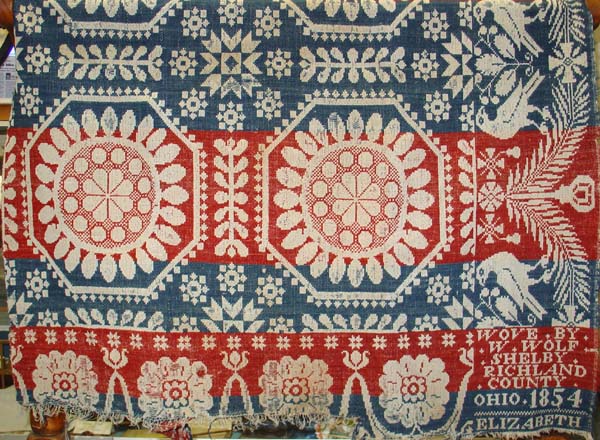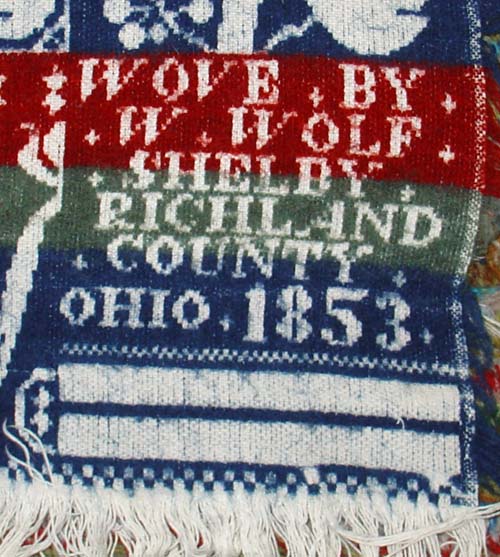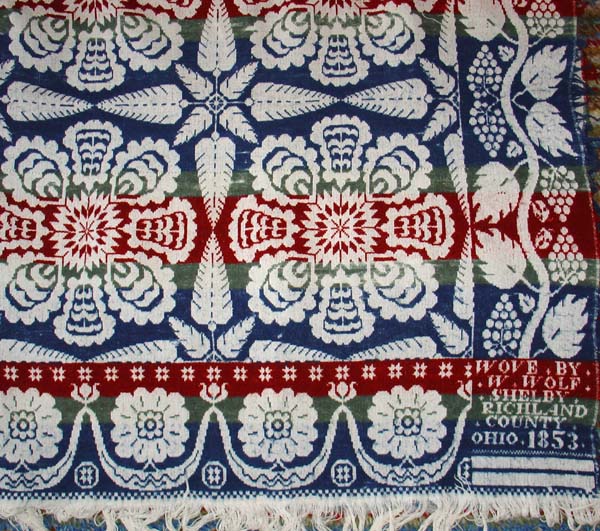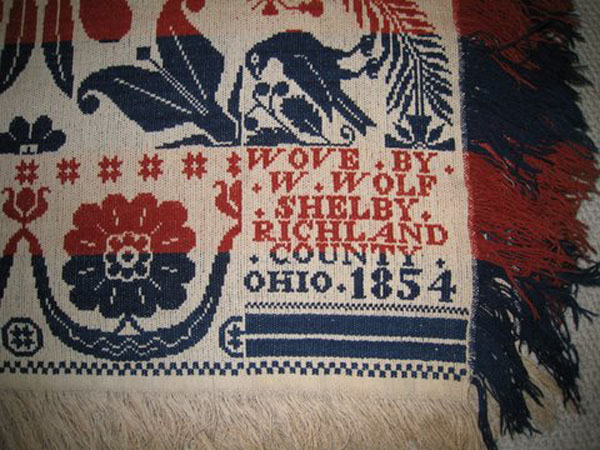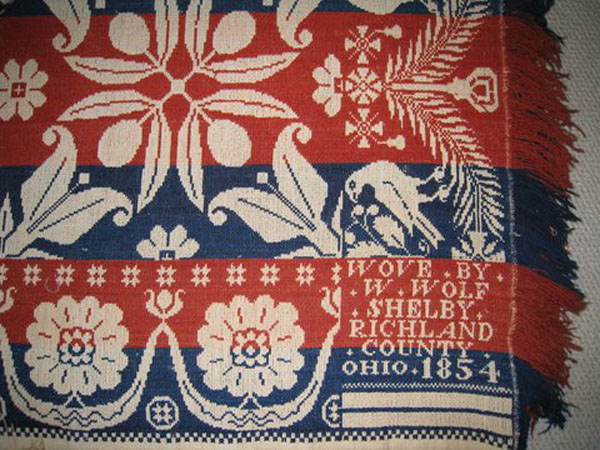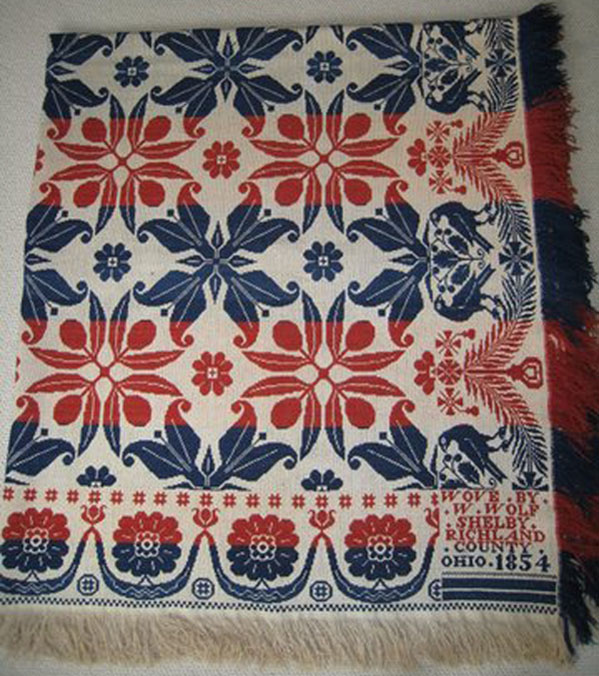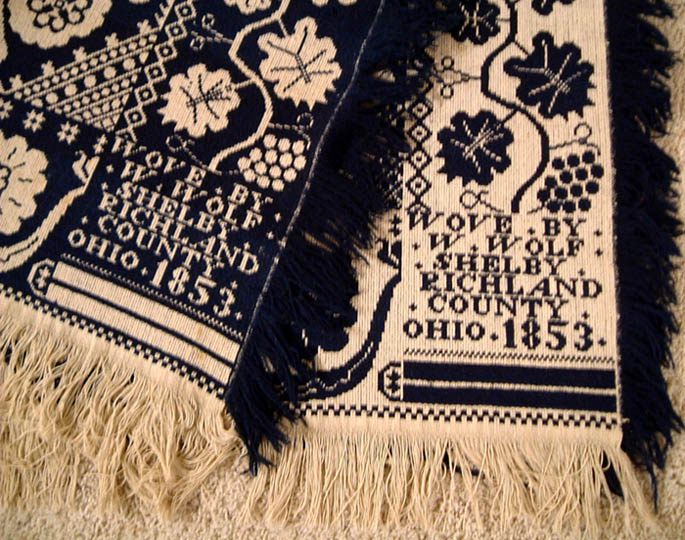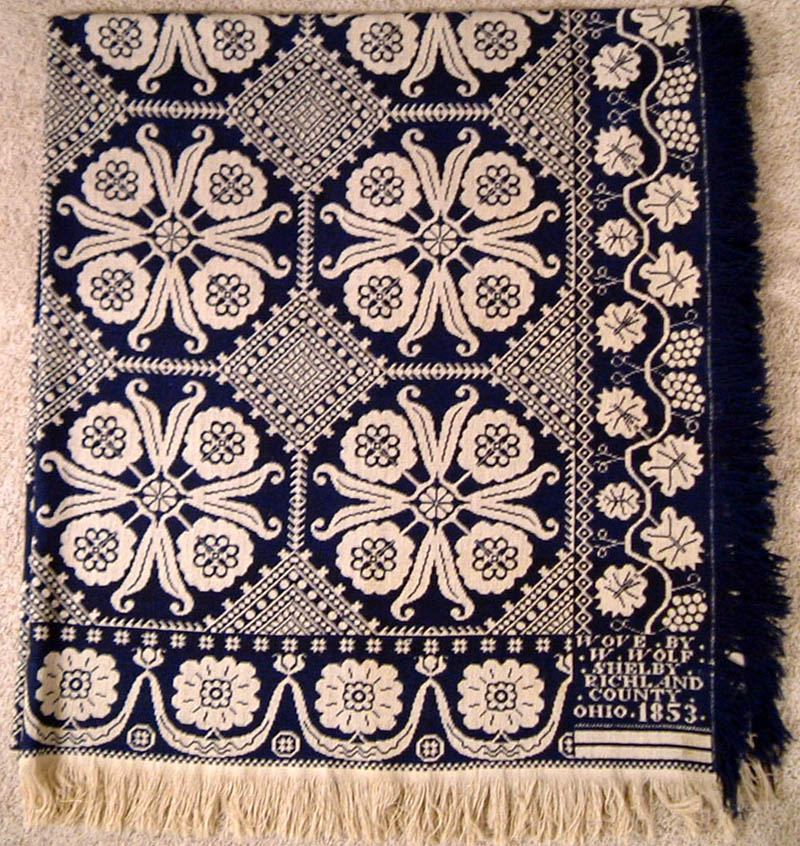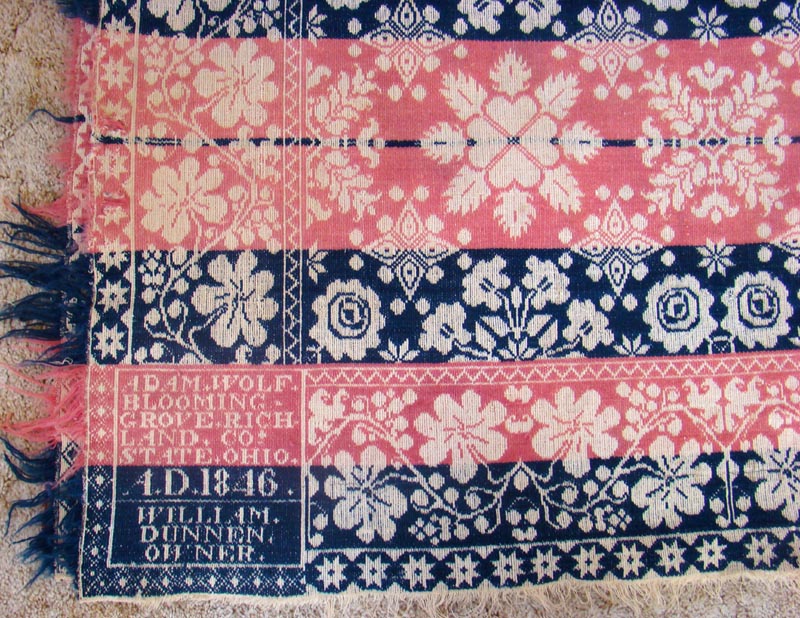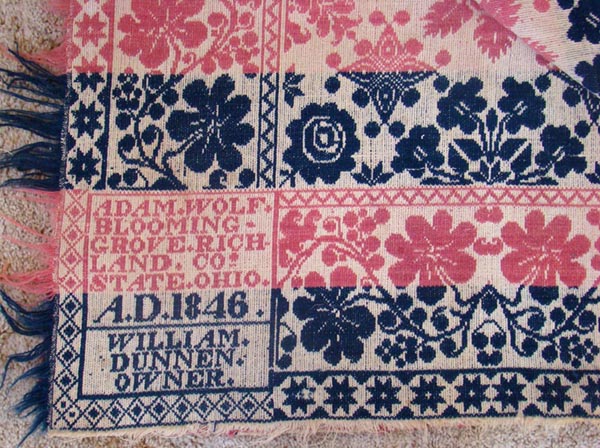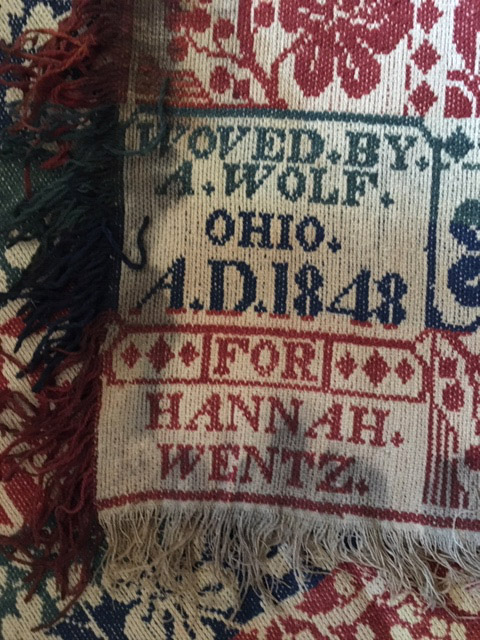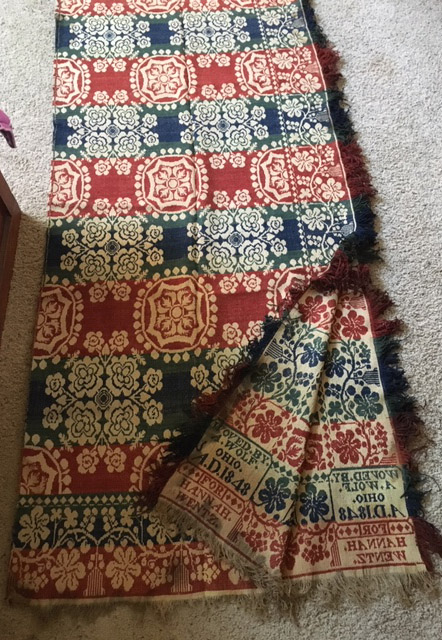-
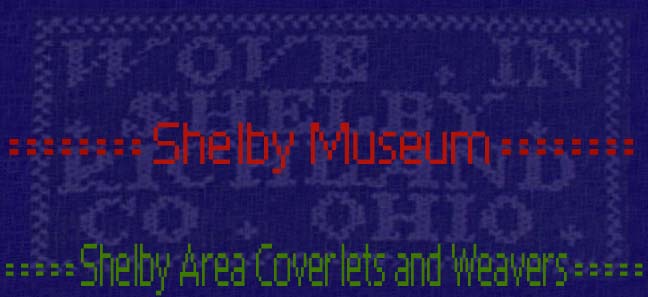
-
-
-
-
- Sometime between 1834, when James Gamble
laid out the first town lots and 1853, when Shelby was incorporated
as a village, there started an era in which certain draperies,
rugs and bed coverings were manufacturered by weavers located
in our area. Their products varied in design and intricacy, but
their durability was outstanding and although it has been over
165 years since many of these items were woven, their beauty
and designs continue to please the eye and their condition is
often amazingly good. The bedcoverings were called counterpanes
or coverlets.
-
- The 1850 census
in this area reveals some interesting facts that pertain to weaving.
There are individuals who list their occupation as weavers, rug
weavers, coverlet weavers and coverlet makers to name several.
In 1850, the occupation of "weaver" could denote several
types of weaving. The use of a portable table or floor loom allowed
the manufacture of bed coverings, rugs, etc. of a simple or random
pattern. This loom was easily portable and could be moved from
community to community with little effort. The production of
woven floral or geometric patterns required a more sophisticated
and less portable loom.
Prior to 1800, a patterned woven bed covering or drapery was
produced on a draw - loom (of various types) that enabled certain
specific woven strands (warp) to be raised or, less frequently,
lowered in relation to the remaining strands of warp. The weaver's
shuttle with the single crosswise running strand (weft) was passed
through these "warped" strands and pressed against
the previous weft strand. Another grouping of warp strands were
then selected and raised (drawn) and the shuttle with the weft
strand was again passed and in this "one at a time"
manner, the desired pattern was made. This was an intricate and
time consuming operation and nearly impossible for a single operator
to accomplish. For that reason the weaver usually employed a
boy 12 to 18 years of age who usually sat atop the loom to "draw"
up the correct selection of warp strands and allow the weaver
to operate the loom and shuttle. A good combination of weaver
and "draw boy" could complete up to 1 to 2 weft strands
a minute depending also on the complexity of the design. An examination
of the number of weft strands per inch indicates how much time
is involved in the making of a woven patterned coverlet. This
time does not include any changing of strand colors.
In 1728 Lois (or Jean) Falcon first used a card with punched
holes and a specially designed device mounted on top of the loom
to aid the loom boy in the process of drawing up the warp strands.
The loom boy selected the correct card and held it against a
surface that controlled the rods that he previously had used
to raise the proper warp strands. The position of the holes in
the punched card "selected" the proper strands of warp
to be drawn up and the shuttle could then be passed. Another
punched card was selected and pressed against the surface and
another pass could be made by the shuttle. The cards were chosen
in the proper sequence and the desired pattern was made. This
process was an improvement; however, it still required two people
to operate the press and didn't increase production a significant
amount and so it never got much beyond the prototype stage.
Jacques de Vaucanson in 1741 designed a metal cylinder with a
raised patterns of pins (in the manner of the cylinder- playing
music boxes that were popular during that period) that he used
to control the draw rods and therefore create a pattern. The
major problem with the de Vaucanson loom was that it was difficult
and expensive to manufacture the cylinders which had to be created
for every pattern and it meant that once the cylinder was created,
the pattern could not be varied without another completely new
cylinder. It's use was not wide spread and it was soon abandoned.
In 1804 Joseph Jacquard patented a system that used the punched
cards and a special loom attachment as did the Falcon machine.
However, the Jacquard loom made use of a continous loop of punched
cards that automatically advanced with each pass of the shuttle.
There was no further need of a "loom boy". Once the
card loop was designed for the particular pattern that was desired
and the cards were correctly assembled in an endless loop, the
entire weaving process could be handled by the weaver alone.
The Jacquard Loom greatly increased productivity (by a factor
of 10 to 25 times) and allowed for increasing complexity in the
design. If it was desired that the design pattern be changed
somewhat, some of the cards could be changed, or additional cards
added, the design changed and the work could continue. Generally
the cards were not made by the weaver, but purchased from a card
designer. From a closely drawn (and enlarged) example of the
desired finished product, the card designer took measurements
and punched the card blanks in the proper locations. A blank
card has a space corresponding to each warp strand. A hole punched
in any of these locations allowed that strand to be selected.
Therefore each card in the series had the status of each warp
strand (raised or not) for each weft strand in the pattern that
was to be produced. This system was extremely successful. It
was inexpensive to produce the cards, extremely flexible, simple
to change from one pattern design to another and most of all,
it greatly increased the weaver's productivity.
Among those who were greatly impressed with the Jacquard Loom
was Emperor Napoleon, who visited Jacquard's workshop in Lyons,
France in 1805(1). The Emporer issued a decree that
Jacquard should be compensated for his contribution to the French
Society and bestowed on him an annual pension. Jacquard died
in 1834, but his punched card system lived on in the life of
Charles Babagge (born 1791). Babagge had struggled for years
to complete his invention of the "difference engine",
a machine to mechanically "compute" numbers for use
in compiling mathematical tables. In 1836 he saw how the punched
card system used in the Jacquard loom could be used in his newest
idea the "Analytical Engine". The punched card system
in Babagge's Analytical Engine has been long regarded as the
forerunner to the IBM punch card reader and our modern day computer.
The Jacquard Loom attachment was imported into the United States
by the 1820s and by the 1830s it was being used in the manufacture
of draperies and coverlets in Pennsylvania as well as East Coast
states. There were coverlets woven in Ohio in the late 1830s
and early 1840s as the weavers brought their talent westward.
-
- Some of them chose
to practice their trade in the Shelby area for a time. The Shelby
Museum is extremely fortunate to have some outstanding examples
of the coverlet craft in the museum and in the surrounding community.
-
-
-

-
-
-
- -
- - - - - - - Daniel
Wolf Family
- - - - - - - -
-
- Daniel Wolf was born in Dauphin County,
Pa. in 1792 and married Catherine Felty c1814 in Lancaster Co.,
Pa. Their growing family lived in the Lancaster County area for
at least 10 years, but by 1840 they had moved to Franklin Twp.,
Richland Co., Ohio. The 1840 census reveals that the family then
consisted of 4 sons and 1 daughter. By 1850 Daniel and Catherine
were still living in Franklin Twp., but only their son Daniel
and his developing family were living with them. Their son William
born c. 1820 with his wife Rachel and two children were living
in Shelby. William Wolf listed his occupation as coverlet weaver.
-
-
- William Wolf /
Wolfe
-

-
-
- This coverlet is attributed to William
Wolfe and was donated to the Shelby Museum by Mabel Kissel in
memory of her husband Gaylord Kissel. The coverlet was handed
down from the Pittenger family to the Kissel family. It was woven
on a loom with the Jacquard attachment. (All the following coverlets
can be assumed woven with the Jacquard Loom attachment unless
otherwise noted.)
-
-
-
-
-
- (Shelby Museum)
-
-
- Woven in 1852
at about the time of the birth of William and Rachel's daughter
Amanda. Compare the style and the lettering (the 185 portion
of the date) in the corner block with the following coverlet.
-
-
-

-
-
-
- William Wolf /
Wolfe
-
-
-
- (Shelby Museum)
-
- This coverlet was donated to the Shelby
Museum by Eleanor Maxwell.
- It is not known
at this time who Elizabeth (the coverlet buyer) might have been.
-
-
-
-
- (Shelby Museum)
-
-
-
- William and his family only stayed
in the Shelby area a short time after making this coverlet. By
1856 he was living in Pittsford Twp., Hillsdale County, Michigan.
He is listed as a farmer in the 1860 census. It seems to have
been rather typical for a younger male to learn the weaving trade
while still living at home and continue to practice it for several
years after marrying while entering farming. Weaving was an occupation
that could be done in the winter when farming activity was less.
As years passed and farm and family grew, the time spent weaving
frequently diminished.
-
-
- We are extremely fortunate to have
the cooperation of many area residents who have volunteered to
allow their prized examples of coverlets from this area to be
included in our article. Thank you to all who have helped in
this project!
-
-
-
-
- (Provided through
the courtesy of a Shelby area private owner.)
-
-
- This is another brightly colored example
of William Wolf's craftsmanship. It is not certain how the wool
used for the construction of these coverlets was obtained. At
one point, the person who requested the coverlet provided the
wool and requested the colors to be used. The weaver processed
the wool and used his own recipes for it's coloring. As time
passed and conditions varied, the weaver may have purchased the
processed wool and then dyed it, and in later years the wool
in it's final state was purchased by the weaver . The colors
used in this design are frequently used in coverlets, but the
colors are as vivid and vibrant as the day it was completed.
It has been well cared for and was beautifully crafted.
-
-
-
-
- (Provided through
the courtesy of a Shelby area private owner.)
-
-
-
- William and Rachel raised their family
of at least 8 children and continued to farm in the Pittsford
Twp., Hillsdale Country, Michigan area. William and Rachel Wolf
died there in the latter part of the 1800s.
-
-

-
-
-
- Coverlet Surprise
-
- In early 2009
we were contacted by Jane Bussom with the news that her daughter
had spotted a Shelby area coverlet
- in a local antiques/gift
shop. Jane immediately followed up on that information and purchased
the beautiful William
- Wolf coverlet
shown in the following photos. After making the purchase Jane
found our Shelby Museum website article
- and contacted
us and supplied us with the pictures shown below.
-
-
-
- (Photo courtesy
of Robert & Jane Bussom.)
-
-
-
- As the photos
show, the coverlet is in wonderful condition. It must have been
well stored and lightly used.
- The colors are
still vibrant and the wear appears to be very minimal to non-existant.
-
-
-
-
- (Photo courtesy
of Robert & Jane Bussom.)
-
-
-
- The reds show
even better in this photo of the reverse. What a wonderful find!
-
- Since there is
no indication on the coverlet of who the original buyer may have
been, and it will be difficult
- to nearly impossible
to back track to find previous owners, Jane may never know any
more details of the
- coverlets history,
however she plans on making a permanent place for this piece
of Shelby history in her home.
-
-
-
-
- (Photo courtesy
of Robert & Jane Bussom.)
-
-
-
- Jane Doty Bussom
is married to Robert Bussom and both grew up in the Shelby area.
Jane's parents were
- William "Bill"
Doty and Mary Catherine Crum Doty and Robert is the son of William
Robert Bussom and
- Zorada Sheets
Bussom. Many will remember the Bussom's store in Shelby.
-
- This coverlet
is proof that there are still examples of beautiful Shelby area
coverlets available on the market
- today if you keep
your eyes peeled and check all possible places. Never try to
convince yourself that "there
- wouldn't be a
chance of finding a Shelby coverlet there". Because the
"surprise" to this story is that the
- Bussoms live in
Thomasville, Georgia and that "local antiques/gift shop"
is in Georgia.
-
- How did that coverlet
get to Georgia? Jane may never know, but she is certainly glad
that she was there
- to find it a new
"Shelby home" in Georgia.
-
- Congratulations
Bussoms for your terrific discovery and thank you so much for
sharing your good news with us!!
-
-
-

-
-
-
- Another William
Wolf Coverlet Surprise
-
-
-
- A William Wolf
coverlet perhaps commissioned by an early member of the Lantz
family in the Shelby area is now in the proud possession of Mary
Kuehn of Platte City, Missouri and her sister Mrs. Ruth Lantz
of Columbus, Ohio. Mary and Ruth are descendants of the Wolf
family and Ruth is related by marriage to one the Lantz families
in the Shelby area. The coverlet was discovered in a closet of
a Lantz family descendant in the Shelby area.
-
-
-
-
- (Coverlet photos
provided through the courtesy of Mary Kuehn)
-
-
-
-
- Mary said that
Ruth just had the coverlet dry cleaned prior to the picture -
taking and it is obviously beautiful.
- Mary indicates
the coverlet colors are navy blue and buff white.
-
- Mary and Ruth
are grandchildren of Charles Earl and Ottie Rosina Clark Wolf.
Charles is one of at least five children of Oliver J. and Alma
J. Stevenson Wolf. Oliver Wolf was born in 1853 in Blooming Grove,
Richland County, Ohio the same year William Wolf was weaving
this coverlet, probably in downtown Shelby, Ohio. Oliver's father
was Daniel Wolf who married Elizabeth Arnold in November of 1848
in Richland County, Ohio. Daniel Wolf was born c. 1807 in Pennsylvania
and Elizabeth Arnold was born c. 1829 in Ohio.
-
- The relationship
between this Daniel Wolf and the Daniel Wolf and Catherine Felty
Wolf family has not yet been defined, however due to the proximity
of all these Wolf family members in the Blooming Grove Twp.,
area in the 1840s and 1850s, it is quite likely there is a close
relationship. A search of the Blooming Grove cemetery may provide
a few more clues, since Daniel and Elizabeth Wolf continued to
stay in the Blooming Grove area. The 1880 census indicates that
two of Daniel's sisters are living with Elizabeth Wolf (widowed).
This relationship could provide clues to Daniel's parentage.
-
-
-
- (Coverlet photos
provided through the courtesy of Mary Kuehn)
-
-
- Mary and Ruth
would like to determine their Lantz family descendancy and the
possible relationship with William Wolf the weaver of their coverlet.
The results of this research will hopefully be presented here
in the not too distant future.
-
- Thank you Mary
and Ruth for discovering and sharing your wonderfully preserved
William Wolf, Shelby coverlet !!
-
-
-
-
-

-
-
- Adam Wolf / Wolfe
-
-
- We believe that Daniel and Catherine
Wolf's oldest son was Adam, born in 1816. In 1838, Adam married
Mary Ann Zeiters here in Richland County. In 1840, Adam and Mary
Ann were living in Blooming Grove Twp., with no family. In 1850
they are still living in the Blooming Grove Twp., area and Adam
lists his occupation as coverlet weaver. Adam's known coverlets
are dated from 1833 to 1852. (2)
-
- Adam Wolf Jr.
was born c. 1852 in Michigan so the family probably moved from
the Blooming Grove Twp. area to Maple Grove Twp., Barry County,
Michigan sometime between 1850 and 1852. The 1860 census lists
Adam's occupation as a farmer. Adam and Mary Ann as well as many
of their children lived out their lives in Barry Co., Michigan.
-
- We believe there
must be examples of Adam Wolf's coverlets in the Shelby area
and will continue to search them out and hopefully add them to
this article in the future.
-
-
-
-
- March 2010
-
- We found one.
This one has been "used" a lot! But due to its sturdy
construction and quality materials, it has weathered the 160
+ years of use quite well. The pattern is familiar and the constuction
is conventional but the pink color is very striking.
-
-
-
-
-
-
-
-
- (Reverse from
above)
-
-
- A quick review
of the 1840 and 1850 census returns from the Blooming Grove Twp.,
area of Richland County reveals no person named William Dunnen.
Further research will be done to attempt to identify the original
owner of this Adam Wolf coverlet. Any information that you might
want to share will be appreciated!
-
-

-
-
- An Adam Wolf /
Wentz Coverlet Surprise
-
- In early July
of this year (2019) an email was received from Cheryl Martin
Sund in Oregon. It read as follows:
-
- “My grandmother
left me a coverlet when she passed away in 1969 at the age of
92. I assume it was woven by
Adam Wolf. I see you have a photo of one woven for Elizabeth
Wentz. I wonder if this was for her sister?
How would you recommend cleaning this?”
-
- (A later email
mentioned that the coverlet suffered a bit of smoke damage when
their house burned
in 2003 and it needed to be cleaned. )
-
- Accompanying the
email, she sent the following photos:
-
-
-
-
- After checking
the Heinrich - Elizabeth Scheibly Wentz family tree, it was quickly
determined that their second child was Hannah Catherine who was
born on Christmas, 1826 in Perry Co., Pa. She and her family
moved to Richland Co., Ohio c. 1831. This coverlet appears to
have been woven for her on her 21st birthday (1848) just like
her younger sister Elizabeth's (below) 10 years later in 1858.
Hannah's coverlet was woven by Adam Wolf, who was born in 1816
and Elizabeth's coverlet was made by Adam's younger brother Henry,
who was born in 1825.
-
- Everything was
going fine until Cheryl revealed that her grandmother, Lydia
Branch, was born in New Jersey in 1878, married William Lines
in New Haven, Connecticut and was never known to have lived in
Ohio. Hannah Wentz married Adam W. Stine c. 1852 just four years
after receiving her coverlet and lived in the Crestline, Ohio
area all of her life. Hannah must have had her coverlet all those
years until her death in 1901, nine years after husband Adam
had passed on. Meanwhile Cheryl's grandmother, Lydia Branch Lines,
moved with her husband to San Bernardino, California where they
had their second child, Lottie Etta, in 1915.
-
- What was the connection?
Cheryl said she never knew of the Wentz family. Neither her grandmother
Lydia, or Lottie Etta, (Cheryl's mother) ever mentioned a connection
with the Wentz family.
-
- Nothing like a
good mystery! Checking the phone directories in San Bernardino
County, revealed that in 1915 (when daughter Lottie, named for
Willam's mother, was born) William and Lydia were living in Redlands,
San Bernardino County, California and were farming an orange
grove. They were living in Redlands in 1920 and also when husband
William died there in 1929. The 1931, 1933 and 1936 San Bernardino
directories find Lydia Lines living in Redlands with her mother-in
-law.
-
- Returning to Hannah
Wentz Stine and her death in 1901, what typically happens to
personal keepsakes just prior to or at the passing of the mother?
Quite often they are passed to the oldest daughter. In this case
there were two daughters: Eva Elizabeth, born c 1860 and Sarah
Alice, born 1863. Eva, aged 38, had just married Cassius Waring
in November of 1898, and Sarah Alice, aged 36, was still single.
Perhaps at this point Hannah, aged 73 and a widow for seven years,
decided to give the coverlet to Eva Elizabeth for a wedding present
or she may have waited and bequeathed it at her passing. One
of these possibilities must have occurred. October 31st, 1901
finds Eva Elizabeth Stine Waring giving birth to her first child
Walter in Allen County, Kansas. The 1910 federal census shows
the Waring family and Eva's sister Sadie (who never married)
living in Dodge, Kansas. In 1920 the Waring family has moved
on to Redlands, San Bernardino County, California. By 1930 Cassius,
73; Eva, 69; Walter, 28; and Sadie, 63 were all living in Redlands
and were "orange growers".
-
- This places Eva
Elizabeth Waring, 69, four years before her death, in Redlands
growing oranges while Cheryl's grandmother Lydia, aged 52, who
will live another 39 years, is living in the exact same area
and was also involved with growing oranges. Eva Stine Waring
and Lydia Branch Lines (both widows) probably knew each other
from working in the same town at the same profession for over
15 years. What would cause the coverlet to pass from Eva to Lydia?
-
- November, 1932,
sixteen months before Eva Waring passed away, Lydia Lines' daughter
Lottie married James Martin. Eva had no daughter to pass her
coverlet to and her sister Sarah, 65, would never marry. A good
choice might be to give the coverlet to friend Lydia Lines for
her daughter Lottie as a wedding present. Neither Lydia or Lottie
would necessarily know the coverlet's history since the giver
was a Waring and before that a Stine.
-
- Some might say
there are too many uncertainties in this solution, however, as
we all know, life is full of uncertainties. The facts have been
presented and await further discoveries. Cheryl Sund, Lottie's
daughter, after hearing this, was pleased. It seems to tie together
the facts she's been aware of and fills in some blanks that were
question marks.
-


